AUDUBON'S CHRISTMAS BIRD COUNT (CBC)
Have you thought of being a Christmas Bird Count volunteer? Here’s a little you should know:
Before 1900, holiday revelers participated in the Christmas “Side Hunt” where hunters competed for the largest cache of feathers and furs. Frank M. Chapman, an ornithologist and early member of the fledgling Audubon Society, wanted to change all that by initiating the first “Christmas Bird Census.” He and 27 others from across the country counted birds on Christmas Day 1900, coming up with 90 species.
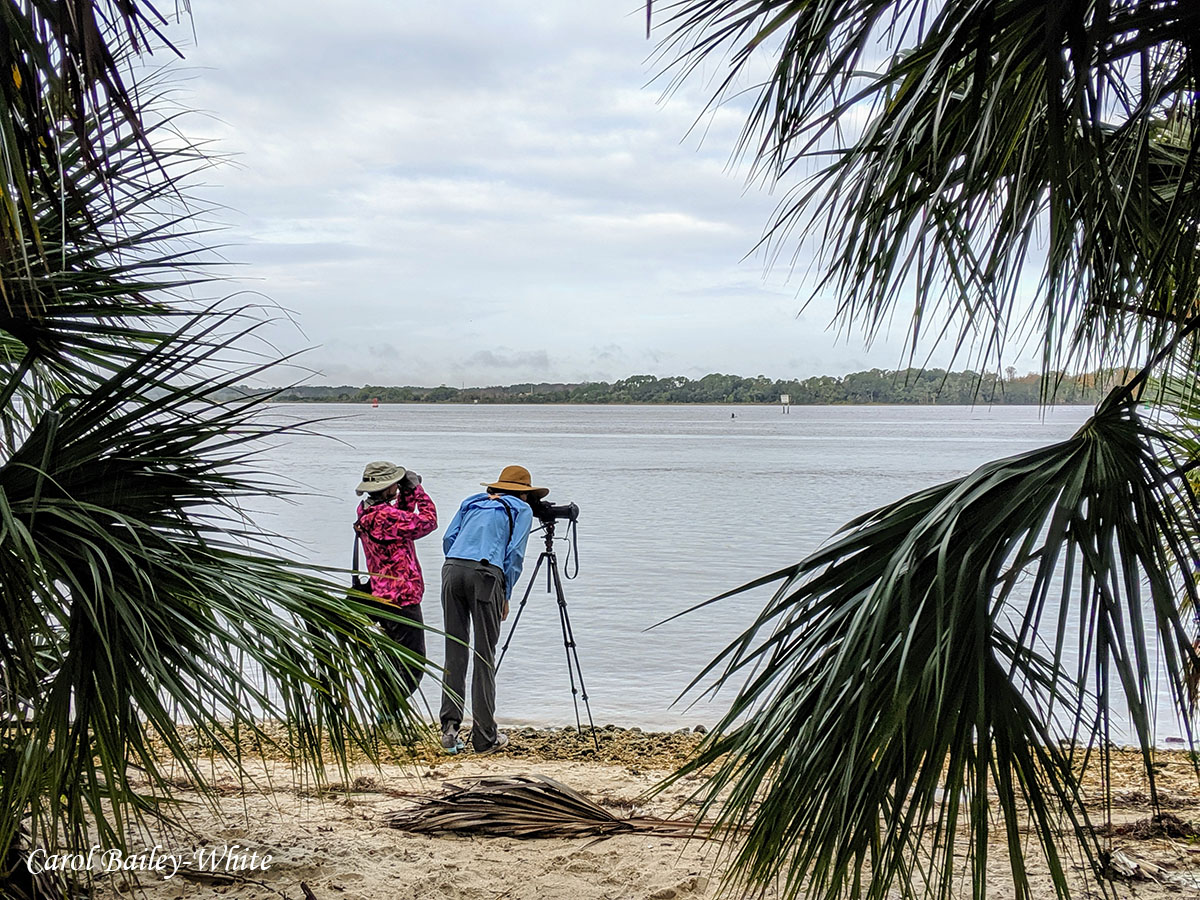 Since then, Christmas Bird Counts have been held annually by Audubon chapters throughout the country, making CBC one of the longest-running collections of bird data. You can find more information about the history and specifics of past CBCs on the Audubon website. You can browse the data from 1901 to the present as well as see all the “circles” where CBC data is collected. Each CBC count circle is a preset, 15-mile diameter circle in which birds are counted. Data from outside the circle is not valid for CBC. Since then, Christmas Bird Counts have been held annually by Audubon chapters throughout the country, making CBC one of the longest-running collections of bird data. You can find more information about the history and specifics of past CBCs on the Audubon website. You can browse the data from 1901 to the present as well as see all the “circles” where CBC data is collected. Each CBC count circle is a preset, 15-mile diameter circle in which birds are counted. Data from outside the circle is not valid for CBC.
The Duval County circle is centered roughly at the northern tip of Little Marsh Island off of Heckscher Drive, and encompasses an area west to east from just east of the Jacksonville Zoo and Gardens into the Atlantic Ocean and from north to south from just below Amelia Island to just south of Atlantic Boulevard. It’s a large area, but it’s divided into groups, each with a leader and several volunteers. It is important that the counters don’t overlap and that they don’t go out of the circle.
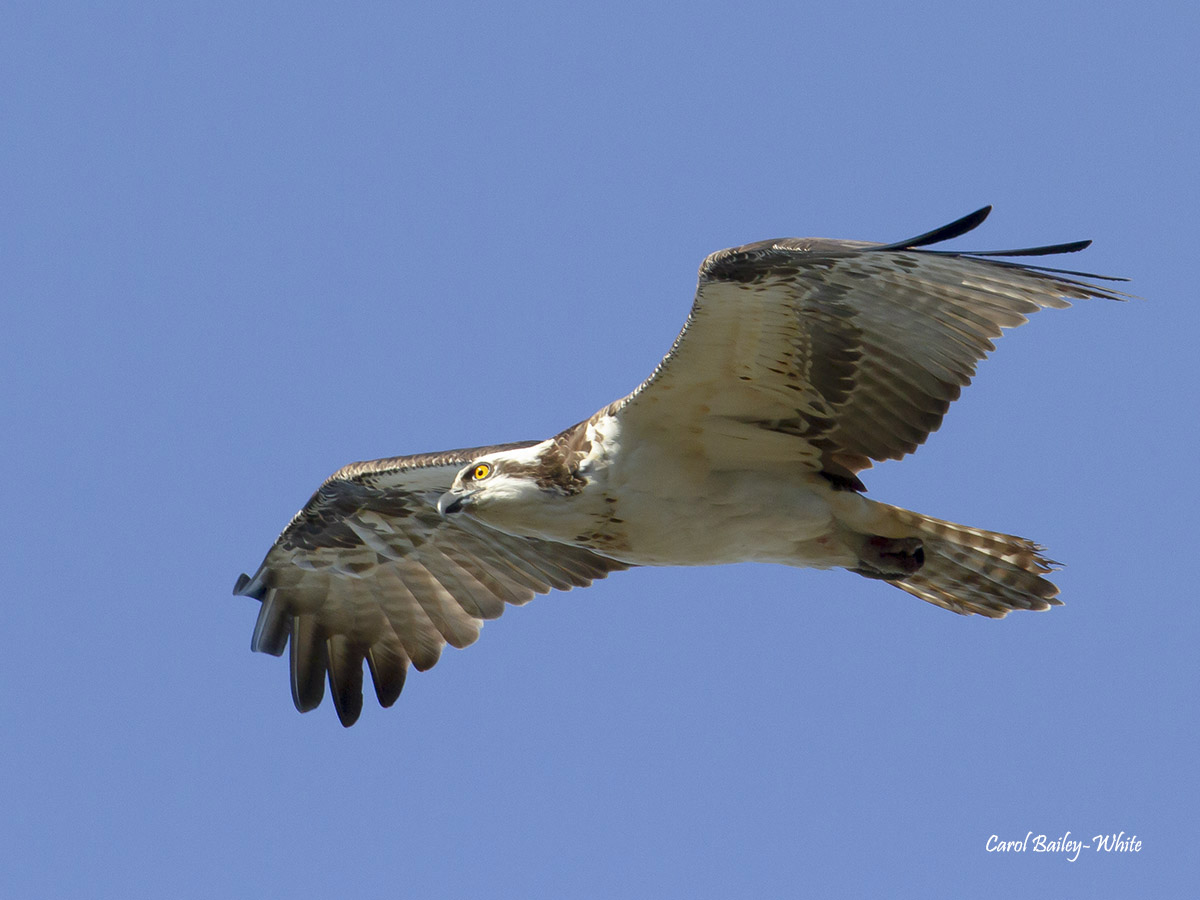 This year, the Duval County CBC will be held on Sunday, December 26, 2021. It runs from sunrise to sunset and a count of all the wild birds seen (even pigeons, but not domestic birds) will be reported. In general, about 50 volunteers are needed for the day, and the total number of species reported is typically between 150 and 165. CBC leaders are looking for birders with at least a moderate knowledge of our area's wintering birds and the ability to research unknown birds for the count. Photos are good, especially for birds in question. While beginning birders can participate, they are encouraged to join with more experienced birders. This is an all-day activity and occurs rain or shine, chilly or warm, windy or calm. Please contact Duval County count compiler Anne Turner at sungrebe86@yahoo.com if you are interested in participating. This year, the Duval County CBC will be held on Sunday, December 26, 2021. It runs from sunrise to sunset and a count of all the wild birds seen (even pigeons, but not domestic birds) will be reported. In general, about 50 volunteers are needed for the day, and the total number of species reported is typically between 150 and 165. CBC leaders are looking for birders with at least a moderate knowledge of our area's wintering birds and the ability to research unknown birds for the count. Photos are good, especially for birds in question. While beginning birders can participate, they are encouraged to join with more experienced birders. This is an all-day activity and occurs rain or shine, chilly or warm, windy or calm. Please contact Duval County count compiler Anne Turner at sungrebe86@yahoo.com if you are interested in participating.
Even if you can’t participate in the December 26th all-day count, if you live within the count circle you can keep a list of birds you have seen in your yard or neighborhood. Please contact Anne if you plan to participate in this way; she will need your address and the amount of time you spent birding.
Other local CBCs are:
- December 18 – Clay County East (hosted by Duval Audubon), contact Steve Raduns
- December 19 - St. Augustine area (hosted by St. John’s County Audubon), contact Linda Burek
- January 2, 2022 – Matanzas area (hosted by St. John’s County Audubon), contact Sue Killeen
~ Carolyn Antman, Conservation Director for Duval County
NEW FLORIDA STATE BIRD?
Contrary to popular belief, Florida has no official state bird. The Florida Senate passed a resolution in 1927 naming the Northern Mockingbird as our state bird but that bill was never confirmed by the Florida House of Representatives or signed into law by the Governor. Nevertheless, any Google search will return the Northern Mockingbird as Florida’s official avian symbol.
 Now, many in Florida want to change that, but not everyone agrees on what our new state bird should be. According to a recent NPR story, there are four main contenders for the title: the Florida Scrub-Jay, the American Flamingo, the Roseate Spoonbill, and the Osprey. State senator Jeff Brandes has filed a bill to remove the Northern Mockingbird as the state bird of Florida, and there are two bills under consideration in the Florida legislature for naming the Florida Scrub-Jay as Florida’s official state bird (SB 378 and HB 207). Those bills may be taken up as early as January 2022, when the 2022 Florida legislative session is scheduled to begin. Now, many in Florida want to change that, but not everyone agrees on what our new state bird should be. According to a recent NPR story, there are four main contenders for the title: the Florida Scrub-Jay, the American Flamingo, the Roseate Spoonbill, and the Osprey. State senator Jeff Brandes has filed a bill to remove the Northern Mockingbird as the state bird of Florida, and there are two bills under consideration in the Florida legislature for naming the Florida Scrub-Jay as Florida’s official state bird (SB 378 and HB 207). Those bills may be taken up as early as January 2022, when the 2022 Florida legislative session is scheduled to begin.
Why not keep the Northern Mockingbird as our state bird? It’s one of the most prolific birds in our state and is among the top singers of all wild birds, often able to reproduce up to 200 different sounds (including car alarms, sirens, and even cell phone ringtones). The problem is, four other states (Arkansas, Mississippi, Tennessee, and Texas) also have the Northern Mockingbird as their state bird.
Advocates for the Florida Scrub-Jay point out that this species is the only bird endemic to our state and is found nowhere else in the world. In addition, Florida Scrub-Jay numbers have declined 90% over the last century, primarily due to habitat destruction and fragmentation caused by conversion of suitable scrub habitat for agriculture and development. The species is listed as Threatened by the US Fish and Wildlife Service and the Florida Fish and Wildlife Conservation Commission, so Florida Scrub-Jay advocates hope that by designating it as our state bird, more conservation dollars will be devoted to saving this rapidly declining species.
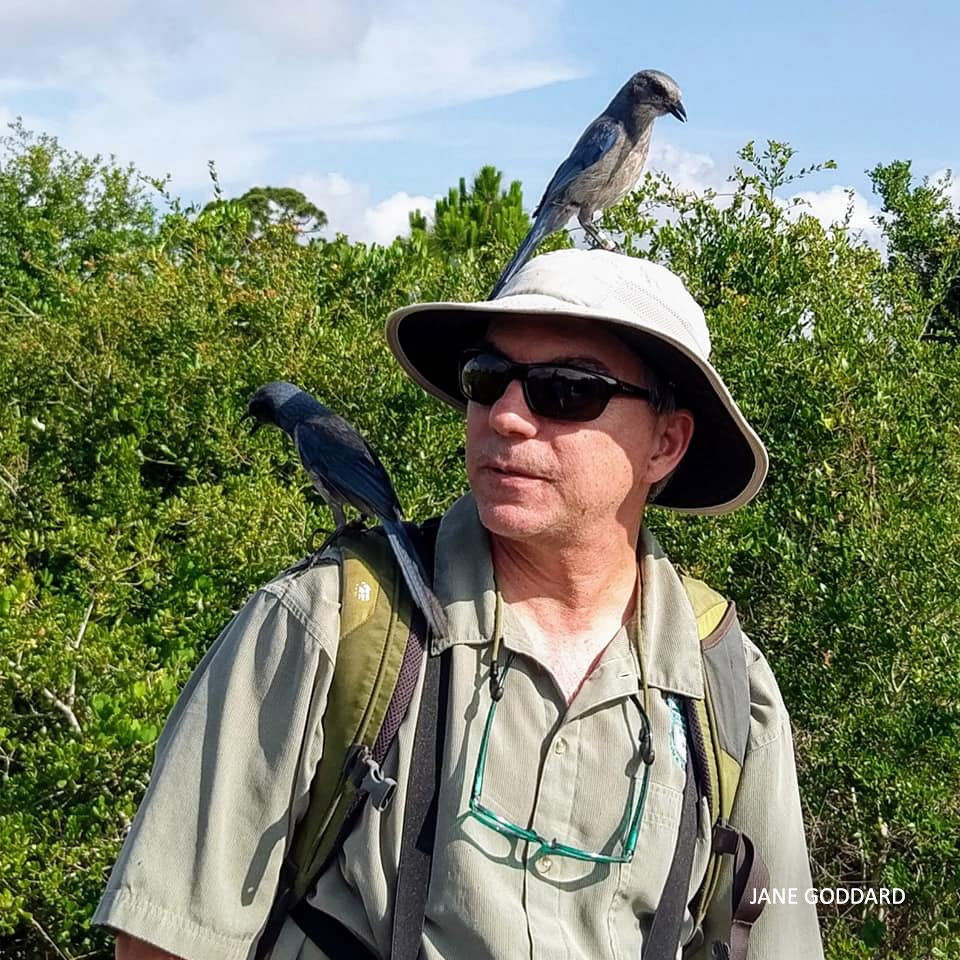 While we love all of the contenders, our chapter supports the designation of the Florida Scrub-Jay as Florida’s new state bird. Not only is it Florida’s only endemic bird and is also listed as a Threatened species, it is also an incredibly charming representative for our state. With its beautiful blue and gray coloring, curious and gregarious disposition, and strong family ties, it is an absolute joy for bird lovers to encounter this species in the few remaining spots in our state where they can be found. Although finding this species in our Northeast Florida area is nearly impossible (most are concentrated in Central Florida), conservation of the Florida Scrub-Jay is critical to avoiding the loss of this lovely bird. While we love all of the contenders, our chapter supports the designation of the Florida Scrub-Jay as Florida’s new state bird. Not only is it Florida’s only endemic bird and is also listed as a Threatened species, it is also an incredibly charming representative for our state. With its beautiful blue and gray coloring, curious and gregarious disposition, and strong family ties, it is an absolute joy for bird lovers to encounter this species in the few remaining spots in our state where they can be found. Although finding this species in our Northeast Florida area is nearly impossible (most are concentrated in Central Florida), conservation of the Florida Scrub-Jay is critical to avoiding the loss of this lovely bird.
You can voice your support for naming the Florida Scrub-Jay as our official state bird by contacting your Florida legislators before January 11th start of the 2022 legislative session to let them know you support SB 378 and HB 207, and encouraging friends and family to do the same.
~ Carol Bailey-White, President
WINTERING SPECIES IN NORTHEAST FLORIDA
By now fall migration is mostly over, and while a few late-migrating birds may still be traveling through our area, most species that winter in the Caribbean and South America have already flown south. But what about birds that winter here? Here are four awesome birds that we typically only see in Northeast Florida during the winter months:
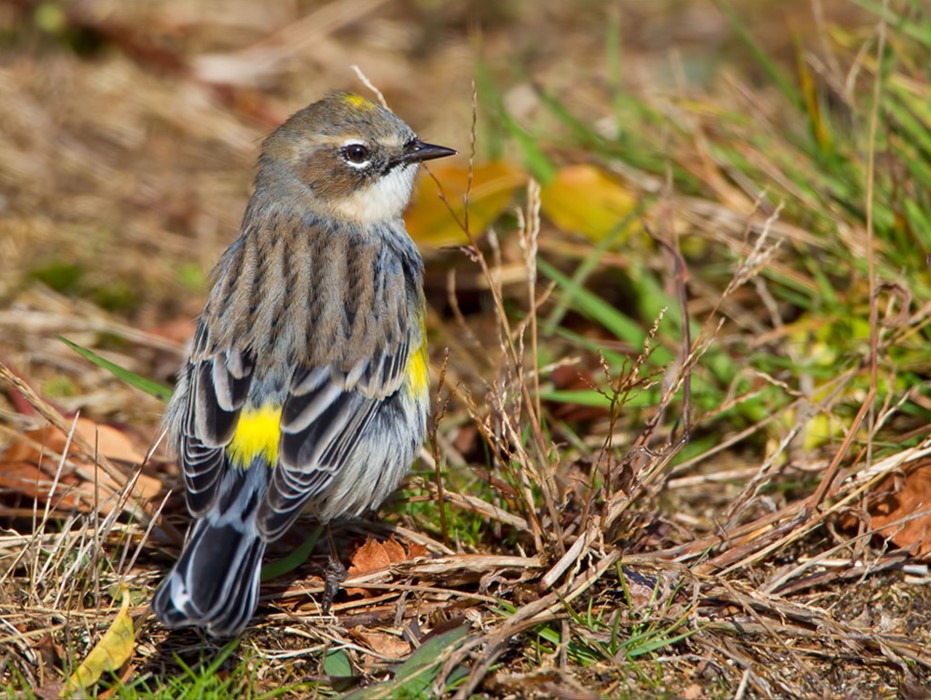 Yellow-rumped Warbler – this species typically arrives in our area in late October and begins migrating back north to their breeding territories across the northern US and Canada in early April. Yellow-rumps (or “butterbutts,” as many affectionally call them) have a lot of variation in their coloring: some have darker streaking on the breasts and darker facial markings. Some show brighter yellow patches on their sides, and to add to the confusion, there are two sub-species that we might see in our area: the Myrtle Warbler, which typically has a white throat patch and more brownish overall coloring, and the Audubon’s Warbler, which has a yellow throat patch and grayer coloring. The Myrtle subspecies is more frequently seen in Northeast Florida, but both subspecies have a broken white eye ring and that bright yellow rump patch for which they are named. During the winter months they feast on berries like bayberry and wax myrtle, and they will also eat the berries of red cedar, poison ivy, and poison oak. They may also visit feeders, where they will take sunflower seeds, raisins, peanut butter, and suet. Yellow-rumped Warbler – this species typically arrives in our area in late October and begins migrating back north to their breeding territories across the northern US and Canada in early April. Yellow-rumps (or “butterbutts,” as many affectionally call them) have a lot of variation in their coloring: some have darker streaking on the breasts and darker facial markings. Some show brighter yellow patches on their sides, and to add to the confusion, there are two sub-species that we might see in our area: the Myrtle Warbler, which typically has a white throat patch and more brownish overall coloring, and the Audubon’s Warbler, which has a yellow throat patch and grayer coloring. The Myrtle subspecies is more frequently seen in Northeast Florida, but both subspecies have a broken white eye ring and that bright yellow rump patch for which they are named. During the winter months they feast on berries like bayberry and wax myrtle, and they will also eat the berries of red cedar, poison ivy, and poison oak. They may also visit feeders, where they will take sunflower seeds, raisins, peanut butter, and suet.
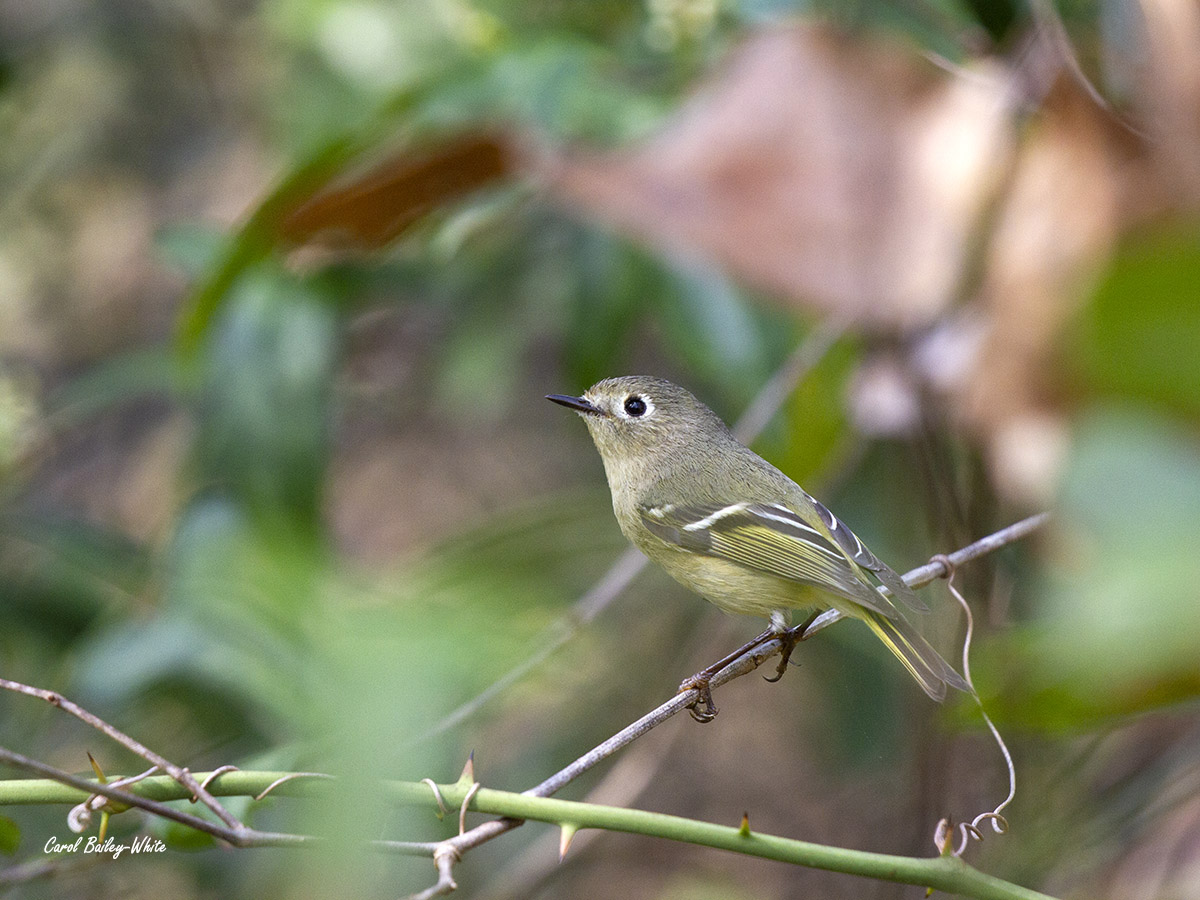 The Ruby-crowned Kinglet is another species that arrives in our area in late October and stays through early April, when they start migrating back to their nesting grounds across Canada. Kinglets are a tiny, active species, and are often seen jumping from branch to branch through the tree canopy to glean insects from the surface of leaves and branches. Seeds and berries form a small part of their diet as well. They are fairly easy to identify, with distinctive white crescents in front of and behind their eyes, overall olive coloring, and a single white wingbar with dark barring just behind it. Males have a “crown” of red feathers on top of their heads that they display when agitated, but otherwise this feature is hidden. Count yourself lucky if you’ve seen the ruby crown on a Ruby-crowned Kinglet! The Ruby-crowned Kinglet is another species that arrives in our area in late October and stays through early April, when they start migrating back to their nesting grounds across Canada. Kinglets are a tiny, active species, and are often seen jumping from branch to branch through the tree canopy to glean insects from the surface of leaves and branches. Seeds and berries form a small part of their diet as well. They are fairly easy to identify, with distinctive white crescents in front of and behind their eyes, overall olive coloring, and a single white wingbar with dark barring just behind it. Males have a “crown” of red feathers on top of their heads that they display when agitated, but otherwise this feature is hidden. Count yourself lucky if you’ve seen the ruby crown on a Ruby-crowned Kinglet!
Yellow-bellied Sapsucker – 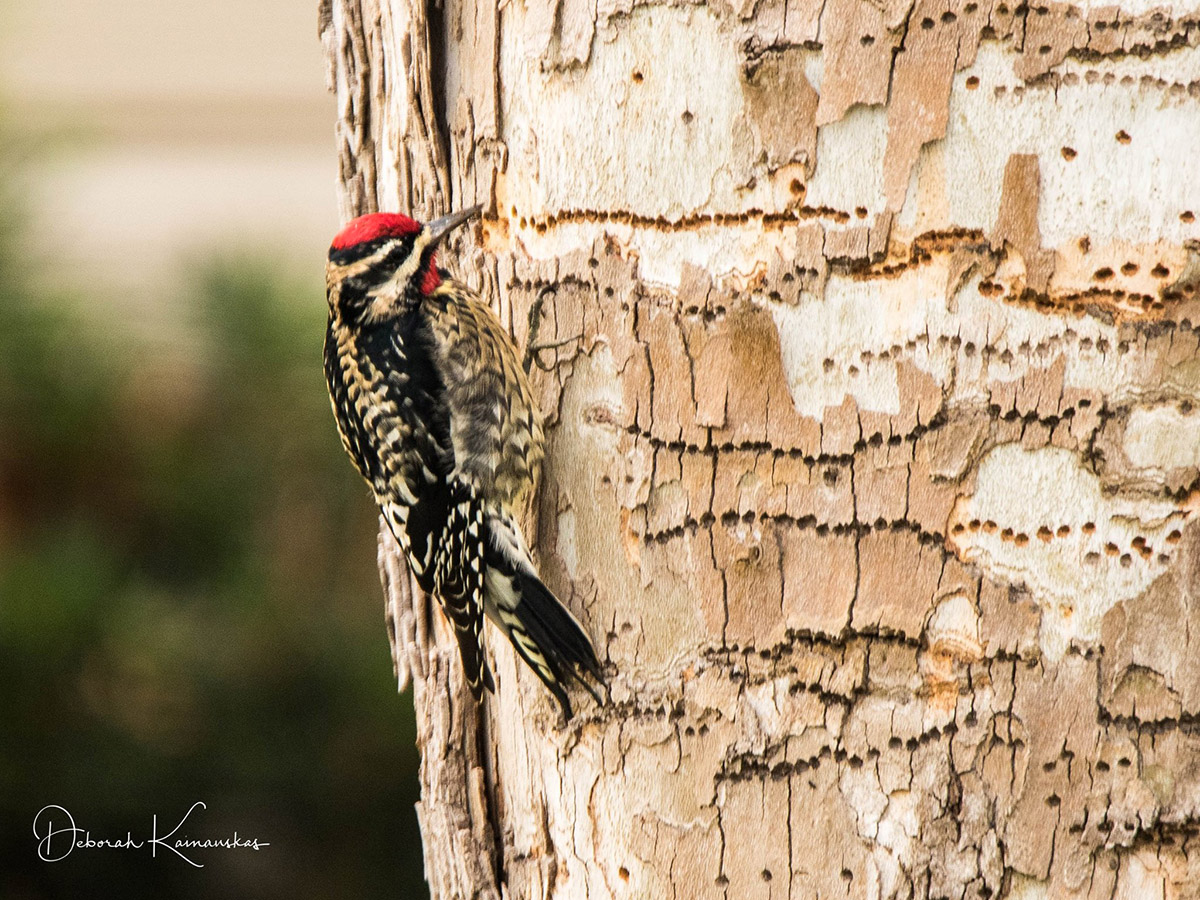 we also start seeing this woodpecker species in October, but they leave us a little earlier than the other two; most are already on their way back to their nesting grounds across the northern US and Canada by the end of March. As their name implies, sapsuckers rely on sap as their main food source, drilling neat holes in horizontal rings around the trunks of trees with sweet sap like birches or maples. They also eat insects, mostly ants, and will sometimes come to suet feeders. This species is easy to recognize, with black and white patterning on their backs and a vertical white wing patch along the front edge of their closed wings. Males and females both have a red cap, with males also sporting a red throat patch. Juveniles are much browner and duller overall than adult birds but still show the distinctive white wing patch. we also start seeing this woodpecker species in October, but they leave us a little earlier than the other two; most are already on their way back to their nesting grounds across the northern US and Canada by the end of March. As their name implies, sapsuckers rely on sap as their main food source, drilling neat holes in horizontal rings around the trunks of trees with sweet sap like birches or maples. They also eat insects, mostly ants, and will sometimes come to suet feeders. This species is easy to recognize, with black and white patterning on their backs and a vertical white wing patch along the front edge of their closed wings. Males and females both have a red cap, with males also sporting a red throat patch. Juveniles are much browner and duller overall than adult birds but still show the distinctive white wing patch.
Cedar Waxwings  start arriving later, usually in mid-November, but stay a bit longer and begin their migration to their breeding territories across the northern US and Canada in May. Mostly fruit eaters, Cedar Waxwings love cedar berries as well as mistletoe and holly berries, and often feed together in large, active flocks, flying from tree to tree and making high-pitched calls as they fly. These enchanting birds have soft brown plumage on the head and neck, darker brown back and wings, a paler breast blending to yellow coloring on the belly, and sport a jaunty black mask and brown crest. Their straight, square tails are tipped in brilliant yellow, almost looking like they were dipped in gold paint. start arriving later, usually in mid-November, but stay a bit longer and begin their migration to their breeding territories across the northern US and Canada in May. Mostly fruit eaters, Cedar Waxwings love cedar berries as well as mistletoe and holly berries, and often feed together in large, active flocks, flying from tree to tree and making high-pitched calls as they fly. These enchanting birds have soft brown plumage on the head and neck, darker brown back and wings, a paler breast blending to yellow coloring on the belly, and sport a jaunty black mask and brown crest. Their straight, square tails are tipped in brilliant yellow, almost looking like they were dipped in gold paint.
These are just a few of the lovely species that spend their winters with us here in Northeast Florida. We hope you might see a few of these on your wintertime birding adventures!
~ Carol Bailey-White, President
DECEMBER ACTIVITIES
 For our first in-person meeting in over a year, we are thrilled to bring you a presentation by our very own Helen Kehrt, who started birding when she was in her mid-50s and is living proof that it's never too late! Helen will share her fabulous photos from her birding travels over the last several years at our December 20, 2021 meeting in the Club Room at The Garden Club of Jacksonville. For our first in-person meeting in over a year, we are thrilled to bring you a presentation by our very own Helen Kehrt, who started birding when she was in her mid-50s and is living proof that it's never too late! Helen will share her fabulous photos from her birding travels over the last several years at our December 20, 2021 meeting in the Club Room at The Garden Club of Jacksonville.
Meetings start with refreshments and networking at 6:30 pm and programs at about 7:00 pm. We will provide holiday cookies and punch; please feel free to BYOD (Bring Your Own Dinner) and enjoy it during the program. Please also bring your own cup to help cut down on plastic trash at this event. Hope you will join us!
Please register on our Meetup site so we know how many to expect.
COVID-19 NOTE: Masks are not mandatory for vaccinated individuals per the new CDC guidelines, but for the safety of all participants and volunteers, social distancing is strongly recommended, and masks are requested when not eating or drinking.
Here are all of our upcoming activites for December:
- Field Trip @ Little Talbot Island: 8 am, Saturday, December 4, 2021 (register here).
- Field Trip @ Spoonbill Pond: 8 am, Sunday, December 5, 2021 (register here).
- Field Trip @ Taye Brown Regional Park: 8 am, Saturday, December 11, 2021 (register here).
- "It's Never Too Late to Start Birding!" Monthly Program Meeting @ The Garden Club of Jacksonville: 6:30 pm, Monday, December 20, 2021 (register here).
Wishing you and your family a happy and healthy holiday season. We look forward to seeing you soon!
All content by Carol Bailey-White unless otherwise noted.
Duval Audubon Society, Inc.
P.O. Box 16304
Jacksonville, FL 32245
www.duvalaudubon.org
    
|
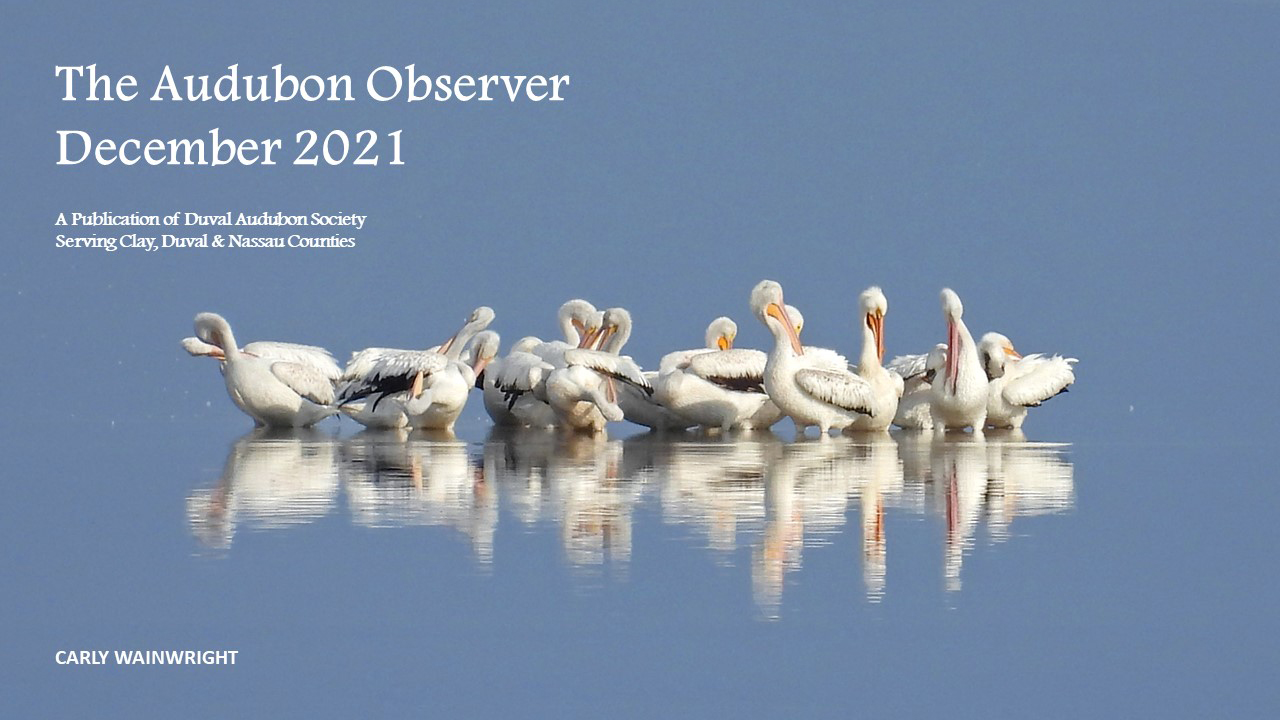
 Since then, Christmas Bird Counts have been held annually by Audubon chapters throughout the country, making CBC one of the longest-running collections of bird data. You can find more information about the history and specifics of past CBCs on the
Since then, Christmas Bird Counts have been held annually by Audubon chapters throughout the country, making CBC one of the longest-running collections of bird data. You can find more information about the history and specifics of past CBCs on the  This year, the Duval County CBC will be held on Sunday, December 26, 2021. It runs from sunrise to sunset and a count of all the wild birds seen (even pigeons, but not domestic birds) will be reported. In general, about 50 volunteers are needed for the day, and the total number of species reported is typically between 150 and 165. CBC leaders are looking for birders with at least a moderate knowledge of our area's wintering birds and the ability to research unknown birds for the count. Photos are good, especially for birds in question. While beginning birders can participate, they are encouraged to join with more experienced birders. This is an all-day activity and occurs rain or shine, chilly or warm, windy or calm. Please contact Duval County count compiler
This year, the Duval County CBC will be held on Sunday, December 26, 2021. It runs from sunrise to sunset and a count of all the wild birds seen (even pigeons, but not domestic birds) will be reported. In general, about 50 volunteers are needed for the day, and the total number of species reported is typically between 150 and 165. CBC leaders are looking for birders with at least a moderate knowledge of our area's wintering birds and the ability to research unknown birds for the count. Photos are good, especially for birds in question. While beginning birders can participate, they are encouraged to join with more experienced birders. This is an all-day activity and occurs rain or shine, chilly or warm, windy or calm. Please contact Duval County count compiler  Now, many in Florida want to change that, but not everyone agrees on what our new state bird should be.
Now, many in Florida want to change that, but not everyone agrees on what our new state bird should be.  While we love all of the contenders, our chapter supports the designation of the Florida Scrub-Jay as Florida’s new state bird. Not only is it Florida’s only endemic bird and is also listed as a Threatened species, it is also an incredibly charming representative for our state. With its beautiful blue and gray coloring, curious and gregarious disposition, and strong family ties, it is an absolute joy for bird lovers to encounter this species in the
While we love all of the contenders, our chapter supports the designation of the Florida Scrub-Jay as Florida’s new state bird. Not only is it Florida’s only endemic bird and is also listed as a Threatened species, it is also an incredibly charming representative for our state. With its beautiful blue and gray coloring, curious and gregarious disposition, and strong family ties, it is an absolute joy for bird lovers to encounter this species in the 
 The
The  we also start seeing this woodpecker species in October, but they leave us a little earlier than the other two; most are already on their way back to their nesting grounds across the northern US and Canada by the end of March. As their name implies, sapsuckers rely on sap as their main food source, drilling neat holes in horizontal rings around the trunks of trees with sweet sap like birches or maples. They also eat insects, mostly ants, and will sometimes come to suet feeders. This species is easy to recognize, with black and white patterning on their backs and a vertical white wing patch along the front edge of their closed wings. Males and females both have a red cap, with males also sporting a red throat patch. Juveniles are much browner and duller overall than adult birds but still show the distinctive white wing patch.
we also start seeing this woodpecker species in October, but they leave us a little earlier than the other two; most are already on their way back to their nesting grounds across the northern US and Canada by the end of March. As their name implies, sapsuckers rely on sap as their main food source, drilling neat holes in horizontal rings around the trunks of trees with sweet sap like birches or maples. They also eat insects, mostly ants, and will sometimes come to suet feeders. This species is easy to recognize, with black and white patterning on their backs and a vertical white wing patch along the front edge of their closed wings. Males and females both have a red cap, with males also sporting a red throat patch. Juveniles are much browner and duller overall than adult birds but still show the distinctive white wing patch. start arriving later, usually in mid-November, but stay a bit longer and begin their migration to their breeding territories across the northern US and Canada in May. Mostly fruit eaters, Cedar Waxwings love cedar berries as well as mistletoe and holly berries, and often feed together in large, active flocks, flying from tree to tree and making high-pitched calls as they fly. These enchanting birds have soft brown plumage on the head and neck, darker brown back and wings, a paler breast blending to yellow coloring on the belly, and sport a jaunty black mask and brown crest. Their straight, square tails are tipped in brilliant yellow, almost looking like they were dipped in gold paint.
start arriving later, usually in mid-November, but stay a bit longer and begin their migration to their breeding territories across the northern US and Canada in May. Mostly fruit eaters, Cedar Waxwings love cedar berries as well as mistletoe and holly berries, and often feed together in large, active flocks, flying from tree to tree and making high-pitched calls as they fly. These enchanting birds have soft brown plumage on the head and neck, darker brown back and wings, a paler breast blending to yellow coloring on the belly, and sport a jaunty black mask and brown crest. Their straight, square tails are tipped in brilliant yellow, almost looking like they were dipped in gold paint. For our first in-person meeting in over a year, we are thrilled to bring you a presentation by our very own
For our first in-person meeting in over a year, we are thrilled to bring you a presentation by our very own